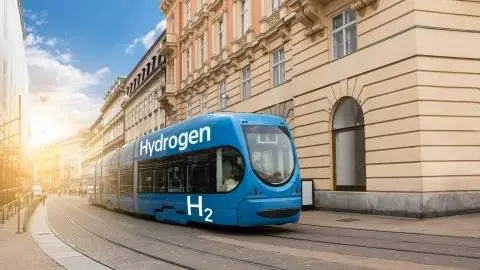Hydrogen: Fuelling the future
Greening the national power supply with solar panels and wind turbines may be relatively easy compared with transforming our heating systems. Hydrogen can deliver both power and heat and that's what makes it a hot topic right now. In this article, we discuss different types of hydrogen and the growth prospects of each of them
Demand: a promising alternative to fossil fuels in all aspects of energy use
Our energy transition scenarios show that fossil fuel use is the main cause of the global greenhouse gas emissions that contributes to global warming. We must drastically reduce the use of fossil fuels if we are to reach the Paris Agreement Climate Goals of keeping global warming to well below 2°C and to pursue the even more ambitious goals of limiting the temperature increase to 1.5°C.
Hydrogen based solutions provide huge potential in helping reduce fossil fuel demand in all the major areas of energy use: heating, transportation, electricity and feedstock. It can, for example, be burned to generate the heat necessary to produce cement and steel or for the heating of buildings. In transportation, trucks, aeroplanes and ships could be powered through hydrogen-fuelled engines. And power plants can be designed to run on hydrogen instead of gas. Hydrogen can also be used as a feedstock, in the production, for example, of fertilisers.
Both governments and companies have set ambitious carbon reduction targets which have made hydrogen and its environmental benefits, a very hot topic.
Hydrogen could shake up the energy chain in many ways
Hydrogen can meet demand for low carbon electricity...
19% of global energy demand is related to the use of electricity, according to the latest World Energy Outlook from the International Energy Agency (IEA). Most of the power is used in buildings and factories and to a much lesser extent, in transportation.
Proven, mature and low-cost technologies such as wind turbines and solar panels, are already available to generate green electricity. It is therefore relatively easy, both technically and economically, to increase the share of renewable electricity in the power sector. The European Commission, for example, recently increased its renewable energy target for the power sector in its Fit for 55 strategy to 65% by 2030, up from the previous target of 55%. Furthermore, power plants can be built to run on hydrogen instead of gas and thereby produce electricity with almost zero carbon emissions.
…and ‘store’ the power for later use
The problem with electricity is that it is not easy to store in large quantities for long periods. Batteries, for example, can only store relatively small amounts of electricity for short periods of time. Economically, it is really only feasible to store electricity in batteries for up to a couple of days.
Hydrogen could help overcome this problem by playing a major role in the storage of electricity in future energy systems that rely heavily on power generation from renewables. Using hydrogen as a store of energy would involve producing it at times when there is an oversupply of green electricity from wind turbines and solar panels. At a later stage, the hydrogen could then be used to generate electricity again, for example in a hydrogen power plant.
Currently, such processes are not financially competitive compared with traditional fossil fuel power generation. However, technically, hydrogen has the potential to act as a backup facility in future power systems, especially during long periods when the wind is not blowing and the sun is not shining; the so-called ‘dunkelflaute’.
Hydrogen can meet demand for low carbon heat, too
Electricity demand is relatively easy to decarbonise but only accounts for about one-fifth of total energy demand. The real challenge is to decarbonise the other 81% of global energy demand related to heating, transportation and feedstock purposes. These processes require molecules, not electrons, and hydrogen is one of the most promising technologies which are able to provide those ‘green molecules’.
For example, fertilisers (NH3) can be made from hydrogen (H2) and nitrogen (N2) molecules. And hydrogen molecules can also be burnt in furnaces to provide high-temperature heat in the steel, cement and glass industries. It could also provide low-carbon heat in buildings, and hydrogen could also be used to power trucks, aeroplanes and ships.
Supply: five shades of hydrogen
To summarise, future hydrogen demand could come from many different sectors and be used for many different purposes. But of course, that hydrogen first needs to be produced, as it does not naturally exist in a pure form.
Despite the fact that hydrogen is a colourless gas, many colours are now used to distinguish the different ways in which hydrogen can be produced. From grey and blue hydrogen which are produced using fossil fuels to green, orange and purple hydrogen which are produced through electrolysis.
A colourful bouquet of hydrogen production techniques
Hydrogen production techniques
In theory, hydrogen can also be made from biogas instead of natural gas. If the resulting carbon emissions are captured and stored, this technique would yield negative emissions, meaning that carbon emissions are taken out of the air by plants and stored in the ground during the production of hydrogen. However, this technique is not yet used in practice.
Given the importance of negative emissions in creating the energy transition pathways needed to reach the Paris Agreement Climate Goals, it is remarkable that this option has not yet been assigned a colour. We suggest calling it dark green, indicating the significant potential of the technology to reduce emissions.
Facts on current hydrogen production
- Current global production: about 120 MMT which creates yearly emissions of 830 million tons of CO2 (2.2% of global energy-related emissions).
- Over 95% of hydrogen is made out of natural gas without capturing and storing carbon emissions (grey hydrogen).
- Hydrogen is mostly used for its chemical properties, not for energy purposes. Around 70% of hydrogen production is related to oil refining or the production of ammonia and methanol. Oil refineries use hydrogen for sulfur removal. Ammonia (NH3) and methanol (CH3OH) cannot be made without hydrogen (H2).
- 50% of hydrogen is produced deliberately in purpose-built plants, 40% comes as a by-product of manufacturing processes.
- On-site production and hydrogen usage on large industrial sites dominate. Only 8% of global production is sold on a merchant basis directly between producers and consumers.
- There is hardly any intermediate trading and therefore no market indices or benchmarks exist. Prices of traded hydrogen range between €3-12 per kilogram of hydrogen.
- The size of the hydrogen market is estimated to be about €110bn globally, based on onsite production and usage and the trade in hydrogen.
- While these are big numbers, the size of the hydrogen market is still small in relation to the total energy market. In Europe for example, hydrogen consumption is around 1% of total energy consumption.
Sources: BNEF, CEER, DNV-GL, IEA.
Hydrogen scenarios indicate 2% to 8% yearly growth towards 2050
Global carbon emissions need to reach ‘net zero’ by 2050 in order to keep global warming in the lower band of the Paris Climate Agreement goals (close to 1.5°C warming). Net-zero refers to the situation in which yearly global emissions equal the natural absorption of carbon by the climate by, for example, oceans and forests.
There are many different scenarios that would create a net-zero economy by 2050. In this section, we discuss some benchmark scenarios for different power systems that make up a net-zero economy.
Hydrogen scenarios indicate 2% to 8% yearly growth towards 2050
Past and future global hydrogen production in million metric tons (MMT)

Hydrogen production has grown 3% year-on-year since 1975 and currently stands at about 120 million tons (MMT) globally. Future growth will depend on the energy systems used in creating a net-zero economy. Hydrogen certainly has a large role to play in an energy system that is predominantly based on renewables, as it provides clean energy at times when the supply of renewables is low. In such a world, hydrogen production could reach about 1,300 MMT by 2050, meaning 8% growth year-on-year, according to Bloomberg New Energy Finance and most of that hydrogen will be green hydrogen.
Hydrogen also has a big role to play in an energy system that heavily relies on renewables and nuclear power. Hydrogen production could reach around 750 MMT by 2050 in a power system where small modular nuclear plants complement wind, solar and battery technology in the power sector. In this scenario, the electricity that drives hydrogen electrolysers comes from dedicated nuclear power plants. In such a world, hydrogen production could reach around 750 MMT by 2050, meaning 6% growth year-on-year.
Hydrogen production could reach around 195 MMT in a world where fossil fuels continue to play an important role in the energy system. Carbon capture and storage (CCS) is an important technology that could be used to mitigate carbon emissions from fossil fuels. In such a world, most hydrogen production will involve blue hydrogen. Despite the fact that hydrogen production will almost double from current levels, the growth rate will drop from 3% to 2% per year in this fossil fuel-based scenario.
The IEA Net Zero Scenario takes a more holistic approach and allows for the different energy technologies to co-exist next to each other. According to this scenario, both renewables, CCS and nuclear energy have a role to play in a net-zero economy. While individual countries could focus on one specific technology, it all adds up to a more diverse picture at a global level. In such a world, there is room for all the different shades of hydrogen and hydrogen production to grow to about 525 MMT by 2050, implying a future growth rate of 5%.
Future growth depends on policy support, societal preferences and technological advances
These hydrogen scenarios indicate a wide range of possible outcomes for future hydrogen production. At this stage of the transition towards hydrogen, it is impossible to accurately forecast the future nature and level of hydrogen production. It simply is not clear yet how hydrogen will transform energy use in manufacturing, aviation, shipping, trucking and power systems across the globe. As such, all pathways should be seen as possible scenarios, including the well known Net Zero scenario from the IEA.
Key, but highly uncertain, factors that will determine future growth in hydrogen are:
- Policies from governments and public support from society for nuclear energy and the capturing and storage of carbon (purple and blue hydrogen).
- The pace of technological advances at which manufacturers can lower the cost of electrolysers (green hydrogen) and CCS (blue hydrogen).
- Regulatory frameworks and policy support that gives confidence to investors to finance the hydrogen transition in key sectors.
- Investments in the hydrogen value chain, in particular by the oil and gas majors, utilities and grid operators.
- Market conditions in commodity and energy markets, notably the development of gas, power and carbon prices. The recent rise in energy prices, for example, has doubled the cost of hydrogen production.
The other articles in our series shed light on some of these factors.
This publication has been prepared by ING solely for information purposes irrespective of a particular user's means, financial situation or investment objectives. The information does not constitute investment recommendation, and nor is it investment, legal or tax advice or an offer or solicitation to purchase or sell any financial instrument. Read more
Download
Download article
28 October 2021
Hydrogen: The complete picture This bundle contains 4 Articles
